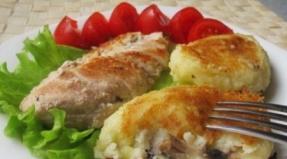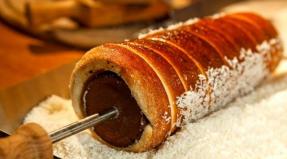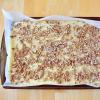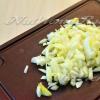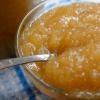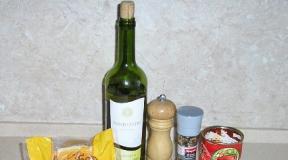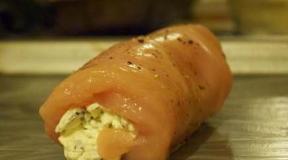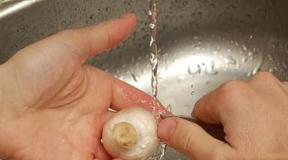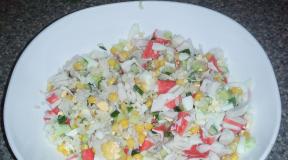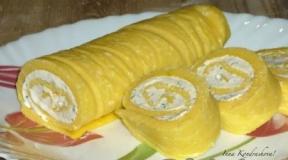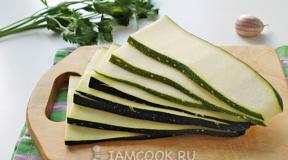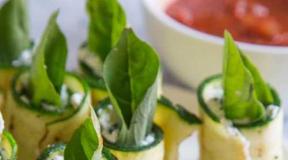National food of Hungary. National cuisine of Hungary
Hungary is a real "treasury" of desserts. It is famous for its culinary traditions, delicious sweets, fragrant pastries.
It is said that some local recipes were borrowed from the time when the country was part of the Austro-Hungarian Empire. But there are also original desserts that were first prepared here. In any case, you should definitely try Hungarian sweets.
Kurteskalach (kürtőskalács)
Kürteskalach can be considered a kind of Hungarian confectionery fast food. You don't need a specialized kitchen to make it. Kyurteshkalach is baked on coals, right on street braziers, winding a thin sweet dough on a metal spit. The result is a fragrant hollow muffin, which is topped with sugar, cinnamon, cocoa, coke chips, chocolate or ground nuts.

Today kürteskalach can be bought in Hungary literally at every turn. It is simply impossible to resist the enchanting aromas of fresh pastries that scatter through the city streets. It costs about 300 Ft and is very popular at fairs and festivals, both on holidays and on weekdays. It is delicious on its own, but sometimes the tubes are filled with soft ice cream.
Retes (retes)
The history of this dessert is intertwined with the culinary traditions of the neighboring country - Austria. It can be considered almost the "twin" of the famous Viennese strudel. The dish is a roll of very thin dough with a filling that can be very diverse: from apples with cinnamon, cherries, curd and cheese mass with the addition of poppy seeds or nuts.

The classic retesh is made from a special dough with a high gluten content, which requires a special “strudel” flour. Hungarian retesh in a cafe and you can try it, paying from 320 to 2,450 Ft per serving.
Kremesh (kremes)
As the name suggests, this popular Hungarian pastry is centered on cream. A dessert prepared according to a traditional recipe must certainly have a lush vanilla-cream layer that melts in your mouth. The delicate taste is emphasized by thin puff pastry with a crispy crust, crumbling into small flakes.

The ingredients used in the preparation of kremesh and its appearance led to the fact that the dessert was often called nothing more than the Hungarian version of the Napoleon cake. It is better to decide on the similarity of these dishes on your own - a piece of creamy pleasure is inexpensive, from 400 to 800 Ft.
Cake "Dobosh" (Dobostorta)
During the Austro-Hungarian era, the confectioners of Budapest competed with their counterparts from Vienna for the privilege of baking sweets for the royal court. The Dobos cake, which is a magnificent result of such rivalry, is now considered a classic Hungarian national dessert. It consists of six thin biscuit cakes with chocolate cream, decorated with caramel icing.

It was Dobosh that became the favorite dessert of Elisabeth, the wife of Emperor Franz Joseph. The cake got its name in honor of its creator, confectioner Jozsef Dobos, who first baked it in 1885, timed to coincide with the National Exhibition. For that time, both the shape and the taste of the cake were truly innovative.
The uniqueness of the dessert was also in the fact that it could be stored without a refrigerator for up to 10 days. This made it possible to transport it over long distances in special boxes made of wood.
For more than 20 years, Jozsef Dobos kept his cake recipe a secret and only published it in 1906, after he retired.Today, one of the most popular desserts in Hungary continues to be baked according to the old original recipe. "Dobos" is sold in pastry shops for 4,500-6,720 Ft, and a piece of branded cake can be bought at a price of 450 to 2,250 Ft, depending on the status of the establishment. The cake is served with a cup of aromatic tea or coffee.
Esterhazy cake (Eszterházy torta)
Another Hungarian cake, whose history dates back to the era of Austria-Hungary. This time the dessert was named after the diplomat, Prince Esterhazy, who 170 years ago served as Minister of Foreign Affairs and was present as an ambassador at the coronation of Alexander II.

For the first time, a cake was baked in honor of the birth of a minister's son in the middle of the 19th century. Crispy almond cakes, melting in your mouth, made a splash, and an unusual delicacy quickly gained popularity among European aristocrats. The cake has taken pride of place among the most famous Hungarian desserts, becoming almost a cult.
The classic Esterhazy cake consists of five layers made from whipped egg whites. Initially, they were baked with almonds, but later they began to replace them with walnuts or hazelnuts. Cakes are connected with butter cream, flavored. On a thick layer of light sugar icing decorating the cake, a grid-like pattern is applied using liquid chocolate.
The price of the cake, which can be purchased at pastry shops in Budapest, starts from 4,500 Ft and depends on its weight. A portion of dessert in cafes or restaurants can be purchased from 550 to 840 Ft. Eat it after the main course, with tea or coffee.
Pancakes in Gundelevsky (Gundel palacsinta)
Another favorite delicacy of tourists and residents of Hungary, named after its creator, is sweet gundel pancakes. This dish was invented in 1910 by the famous chef, one of the founders, Karoly Gundel, with whose name it entered the history of Hungary's national desserts.

The delicacy is thin lace pancakes richly stuffed with a sweet mass of sour cream, raisins, dried fruits, lemon zest and walnuts. From above, gundel pancakes are generously poured with hot chocolate and alcohol tincture. Sometimes dessert is served burning - this effect is given by ignited alcohol. You can taste a portion of the famous pancakes in Budapest restaurants at a price of 1,400 to 2,900 Ft.
Shomloy dumpling (somlói galuska)
One of the most unusual Hungarian sweets is shomloi dumplings. This real gentle madness consists of small pieces of soft nut, vanilla and chocolate biscuit with the addition of raisins and walnuts. The final chord in the preparation of the dessert is impregnation with rum, the addition of butter cream, decoration with whipped cream and patterns of chocolate sauce.

You can try in Budapest a symphony of taste called "Shomloi Dumpling" for an average of 600 - 1790 Ft.
The national cuisine in Hungary could not stand apart, not be influenced by the cuisine of other countries. In the 15th century, the Italian bride of the king transformed the palace cuisine according to the traditions of her country. After the Turkish conquests, recipes were replenished with paprika, which became one of the main ingredients. Certain culinary secrets were borrowed from neighboring Romania. However, culinary specialists from Hungary managed to transform the dishes “in their own way” in such a way that it is almost impossible to recognize the prototypes in them.
Hungarian cuisine has a certain specificity:
- the main assistant in creating dishes is pork fat;
- the first dishes are very hearty and thick;
- there is a lot of meat in recipes, mainly pork, poultry, veal;
- spices, paprika and onions are used in large quantities;
- sour cream is served with all first and second courses;
- The main cooking method is stewing.
Flour is distinguished by the maximum inclusion of gluten. This allows chefs to create unique desserts from the finest dough, as well as tarhonya. These dried granules in the form of cereals are used in soups, side dishes, stuffing.
What is a must-try in Budapest?
You can go to a restaurant of Hungarian cuisine, try the delicacies of this cuisine in Moscow, another city. But if you have the opportunity, go to Hungary to fully appreciate all its advantages. 
Local cuisine includes a huge number of dishes. There are among them the most popular, brightly reflecting the features of this cuisine. In restaurants and cafes in Budapest, be sure to try:
- snacks - stuffed peppers, spring rolls, Debrecen sausages, goose liver pate;
- the first is ukha holasle, goulash;
- the second - paprikash, lecho, perkelt, cabbage rolls in Transylvanian style, roast;
- desserts - kertosh, hungarian cheesecake, strudel.
Be sure to try the Hungarian fast food - langos. This is a fragrant, hearty, deep-fried flatbread. Garlic sauce and sour cream are used for lubrication, grated cheese is sprinkled on top.
In Hungary, it is customary to serve a certain drink with each meal. There are many of them, but you should definitely try them in Budapest.
Recipes for popular Hungarian dishes
Not only visitors to Hungarian cuisine restaurants can try the delicacies of this cuisine. They can be a great addition to your home diet. Recipes of dishes are not very complicated, every housewife will cope with them.
Hungarian goulash
In the preparation of goulash is used:
- veal or pork;
- vegetables - potatoes, tomatoes, carrots;
- paprika, spices;
- onion and garlic;
- homemade noodles or dumplings.
First, onions, carrots, garlic are fried in pork fat for several minutes. Diced meat is added. After 10-15 minutes, paprika is laid out and 250 ml of water is poured. The mixture is stewed for about half an hour, water needs to be added. Diced potatoes, peeled chopped tomatoes are added. A few minutes before the potatoes are ready, dumplings or noodles, garlic, and spices are added to the goulash. Goulash soup sprinkled with herbs. 
Perkelt
In cooking, any kind of meat, fish, mushrooms, crabs can be used. The product is cut, stewed with pork fat, lots of onions and paprika. The dish is dressed with red sauce.
Kertosh
Prepare sweet pastry, wind it on a wooden or metal stick, bake, sprinkle with cinnamon, chopped nuts, pour over honey.
Hungarian cuisine, national and local: what to cook and where to eat. Recipes, cooking methods, snacks, desserts, hot dishes and drinks of Hungary.
- Hot tours to Hungary
- Tours for May around the world
Even those who are not adherents of gastronomic tourism should include a close acquaintance with the cuisine of this country in the program of a trip to Hungary. What distinguishes Hungarian cuisine from other European cuisines is the huge variety of products used.
Products
If we talk about meat dishes, then they can be prepared from pork, pig, beef, veal, game, poultry. Some dishes use different types of meat or meat that has been processed in different ways. The rivers and lakes of the country are rich in fish of various species, so dishes from the Danube catfish, Tissai sterlet, Balaton pike perch occupy an important place in the national cuisine. Various vegetables are also used: eggplants, zucchini, tomatoes, various cabbages and - as the most important components of many dishes - onions and sweet peppers.
For the preparation of seasonings, sour cream is often used in combination with the most unexpected ingredients. It is impossible not to say that Hungarian flour is traditionally used for the preparation of flour products. Its peculiarity lies in the high content of gluten, which allows you to roll out the dough very thinly and make pastries, which have no analogues in the cuisines of other countries. Often, flour mixed with eggs is used to make dough for tarragon - small dried balls that are used both independently and as a side dish or filler for stuffed vegetables.
Cooking methods
The main ways of processing products are boiling, stewing, frying. It does not look as picturesque as grilling, but the taste of the finished dishes is excellent! Of course, each chef has his own secrets and technological techniques that allow you to prepare a delicious and beautiful dish. But there are also common points that, in fact, create that unique taste that is inherent in Hungarian cuisine. One of these features is the widespread use of lard. It is an important component of most dishes, sometimes flour and spices, which are part of the recipe, are fried on it - this gives the dishes the necessary thickness and spiciness. Butter is considered a dietary product by Hungarian chefs and is rarely used in their recipes. Even less often, vegetable oil is used, even in vegetable salads it is usually replaced by melted goose fat.
The second important feature is the use of spices and seasonings. Especially popular are onions, garlic, cinnamon, celery, dill, black and red peppers, marjoram, thyme, cumin and, of course, paprika. There are a lot of varieties, degrees of maturity and ways to use paprika. Ripe, semi-ripe, fresh, dried, crushed fruits can be used ... To this we must add a rich color scheme: green, light yellow, pink, light red, burgundy pepper pods also serve as table decorations. The onion, which is used very widely, moreover, after various heat treatment, also adds a variety of flavors. Interestingly, for some dishes, it should be barely browned in a pan, while for others, it should be fried very strongly.
What to try
Separately, it must be said about the names of dishes. There is some confusion here: the second dish, which in Russia is called goulash, is called maslash in Hungary, and goulash is a very thick spicy soup made from meat and pureed vegetables, cooked with a lot of flour and paprika. And the first name that comes to mind when mentioning Hungarian cuisine is paprikash. This funny word is called almost any dish seasoned with sour cream sauce with paprika.
Perekelt - stew - differs from other dishes in its high content of onions, it is prepared from beef, veal, pork, lamb, poultry and offal. Tokan - resembles perekelt and goulash, but less meat is put in this dish than in goulash, but mushrooms, green peas and greens are added. Separately, it must be said about flour dishes. Noodles with cottage cheese, various rolls, sweet and not sweet, the famous Hungarian cheesecakes - the variety is very large.
The rivers and lakes of the country are rich in fish of various species, so dishes from the Danube catfish, Tissai sterlet, Balaton pike perch occupy an important place in the national cuisine.
Hungarian wines
Speaking of Hungarian wines, one cannot fail to mention the wine about which Voltaire said: “Blessed Tokay amber tickles the brain and gives thoughts the fire necessary for witticisms as bright as a drunken drink ...” Hardly anyone would think to argue with a great philosopher-educator, but to try Tokay, the wine of kings, is simply necessary. By the way, it can be the best gift from a wonderful country with amazing cuisine.
During your trip to Budapest, don't forget to taste the delicious Hungarian cuisine. Hungarian cuisine will definitely please you. After all, her cuisine consists mainly of hearty soups, stews, game dishes, simple but tasty casseroles, juicy pies and pastries.
Here we give you some tips on what dishes you should try while in Budapest.
Hearty and spicy Hungarian dishes are made by some ingredients and a certain method of preparation. The main ingredient is paprika powder, which gives a unique taste and bright orange color to typical Hungarian dishes. But do not be mistaken that red pepper dishes are too spicy.
For the most part, sweet paprika is put in stews, goulash, paprika chicken and hot peppers are usually placed aside.
The main step in creating a real Hungarian stew, goulash, is stewing onions in hot lard with the addition of paprika to it. Sour cream is also another important ingredient in Hungarian recipes. It is added to soups, pastas, casseroles and desserts.
There are also other main ingredients such as onion, garlic, cumin, black pepper and various herbs including parsley, bay leaf, wormwood, celery, thyme, savory.
Although most Hungarian dishes call for lard, nowadays restaurant owners and housewives use vegetable oil instead of lard.
Hungarian soups
It is a nation that consumes soup the most in its diet. A full three-course meal always starts with soup. It can be a hearty meat soup, the world famous goulash or a sweetish vegetable soup.
Each part of Hungary has its own way of making goulash. Green beans are added to dishes called "Palócgulyás" goulash and "Alfoldi" goulash and are then cooked along with potatoes, carrots and parsnips. Hearty bean soups are very popular in Hungary.

In restaurants you can find "Jókai" - bean soup on the menu. Be sure to try the famous "fish soup" in Hungary.

Also, you will find another Hungarian soup on the restaurant menu - "Újházy", that is, chicken broth.
The price varies depending on the order, approximately 400-1000 HUF.
Hungarian main dishes
After the soup, a meat dish is usually served with potatoes, pasta or a rice side dish. Also, meat dishes can be served with pickles or a salad of seasonal vegetables.
The most popular meat dishes are "Pörkölt" and "paprikás". "Pörkölt" is a stew made from pork, beef, lamb or chicken with onions and the main Hungarian spice - paprika powder.

Paprikás is prepared in the same way as pörkölt. The only difference is that sour cream is mixed with red paprika and onion sauce. This is necessary to give the dish a creamy look.
Fried goose liver ("Libamáj") and game dishes are considered Hungarian delicacies.

Cabbage rolls ("Töltött Káposzta") is a traditional Hungarian dish that tastes very good. It is prepared for holidays such as Christmas and Easter.

Hungarian cuisine is characterized by pasta dishes. There are a number of such dishes: "Turos csusza" - pasta with cottage cheese, "káposztás tészta" - egg squares with stewed cabbage and, of course, savory pastas.
Sweet pasta dishes: "túrógombóc" - dumplings, syrniki, "szilvásgombóc" - plum dumplings and "palacsinta" - pancakes.
If you are a vegetarian, try "Főzeléks" - vegetables stewed in water in a thick form. Try also "tökfőzelék" - brain with dill and sour cream, or "finomfőzelék" - mixed vegetables with white sauce.
Restaurants usually serve stewed pork chop or scrambled eggs. It depends on which mixture of "Főzelék" vegetables you have chosen. For the preparation of some "Főzeléks", such as "Babfőzelék", in which beans are added, smoked meat or sausage is important.

If you are a vegetarian who adheres to the rules, then before ordering "főzelék" you can ask the waiter if meat, or even meat broth, was used during its preparation.
The price of such dishes: between 1200-3000 forints depending on the restaurant. Some restaurants may even inflate prices for tourists.
Hungarian pastries, cakes, snacks
For lovers of sweets, it is impossible not to ignore Hungarian sweets: juicy cakes, delicious pastries. The best places to try these sweet goodies are coffee shops and cafes. Take your time with the choice of cakes and pies stuffed with cream, which are displayed in a row behind the counter of shops. Here are some desserts you can try:
"Dobos Torta" - a multi-layer cake with a thick chocolate cream, covered with crispy caramel.

"Eszeteházy Torta" is a multi-layer cake with nut cream.
"Krémes" is a light vanilla cream that is used between two layers of crispy layer cake.

"Rigó Jancsi" is a chocolate biscuit filled with airy chocolate mousse and covered with chocolate.

"Rákóczi Turos" - cottage cheese cake.
Buns - "Retes" - puff pastry with various fillings (cottage cheese, apple, poppy seeds and cherries and others). For Hungarians, these dishes are favorites.
As a rule, "Kürtős kalács" are sold at festivals and outdoor events - a cylindrical hollow dough covered with powdered sugar, cinnamon or walnuts.

"Gesztenye püré" - chestnut puree or "Somlói galuska" - biscuit made of puff dumplings with chocolate sauce, rum and whipped cream are typical hearty Hungarian desserts.
For a quick morning snack, you can try fresh pastries from the bakery, such as "Turos taška" - cookies filled with cottage cheese, or "Kakos Csiga" - "coconut snail" - ball-shaped dough filled with chocolate. In the food section of the vegetable markets, you can buy "Langos" - deep-fried round dough.
Another option for a quick snack is "Pogácsa", salty biscuits with various flavors (greaves, cheese, cabbage).

The price of these dishes: pastries and snacks cost about 150-200 forints, a piece of cake - between 200-400 forints (they cost more in a cafe for tourists).
Every second first tourist who came to Hungary wonders what to eat in Budapest. The national cuisine of the country is rich and original, it is based on meat, onions and paprika, and is also distinguished by a huge number of dishes that combine the first and second. No wonder that an inexperienced gourmet can easily get lost in a large number of titles that have not yet been translated into English or Russian. Therefore, I decided to help you navigate the variety of Hungarian cuisine, and at the same time tell you about the most remarkable dishes that you should definitely try.
Meat and paprika (red pepper seasoning) are present in 90% of all Hungarian national dishes. Moreover, these two main components are so well combined with each other that having tried once, a person falls in love forever. Unless, of course, you hate one of the ingredients listed above :).
Hungarian goulash
The most famous local dish, which has spread far beyond the borders of Hungary itself. Goulash is a must have dish for everyone who comes to Budapest. In Russia and the countries of the post-Soviet space, it is customary to call goulash meat fried, served with a side dish - mashed potatoes, pasta, rice. In Hungary, goulash is a soup.
It traces its history from the camp stew prepared by the Hungarian shepherds. And the name itself can be translated as "shepherd's soup." Shepherd in Hungarian sounds like guyash - gulyás. From ancient times to the present day, Hungarians honor and love goulash, and even a themed festival is held annually in the city of Szolnok.

Hungarian goulash is the same double dish, which is formally a soup, but actually combines the first and second. It is very thick and savory. Prepared from beef or veal, which are pre-fried. Then the meat is stewed with bacon, onions, potatoes and spices. Separately, it is worth highlighting the additives - cumin and paprika, which give the goulash a characteristic red color, a special taste and aroma.
In Budapest, goulash is served in almost any institution of national cuisine. I can’t single out any one restaurant, and I don’t want to. The site has several site-reviews of establishments where goulash is served. Below I will post links to these reviews, in the same place you will find a map with the places about which reviews were written. It lists both the restaurants I personally visited and the reviews from readers.
chicken paprikash
The second most popular Hungarian national dish is s, which can also be found in almost any cafe or restaurant. Paprikash is not considered an exclusively Hungarian creation, as it is also included in the national cuisine of Austria. Previously, paprikash was made from adult chickens to give the dish its characteristic rich taste, but recently Hungarians are moving away from this tradition. Now, for the preparation of paprikash, separate parts are used - chicken breasts or legs. In principle, you can cook a dish not from chicken, any white meat will do:
- Bird;
- fish;
- veal;
- lamb.

But the most popular among Hungarians is chicken paprikash, which was prepared back in the Middle Ages. The main feature of this national dish of Hungary is the sauce and seasonings. Without a lot of special sour cream sauce and constant paprika, chicken paprikash will not be itself. At the same time, sour cream sauce is also used in cooking - chicken is stewed in it - and when serving - they are poured over the already prepared dish. Paprikash is usually served with dumplings or pasta.
Perkelt
As I said, Hungarians are very fond of meat and spices, especially paprika. From these simple ingredients, a large number of national dishes are created.
Perkelt is somewhat similar to Hungarian goulash, and somewhat similar to paprikash, but at the same time it is different from both of these dishes. Simply put, perkelt is still the same stew, but it differs in the way it is prepared. The meat, which can be beef, pork or lamb (in principle, any dark meat is suitable, but these three types are used most often), are finely cut, fried and stewed in a tomato sauce with abundant seasonings.

There is also a special type of perkelt made from mushrooms, the so-called vegetarian. The main difference between perkelt and chicken paprikash is the absence of sour cream sauce, which is compensated by a large amount of paprika and onion. The dish is also served with a side dish of dumplings, pasta or Hungarian dumplings called tarhonya.
Goose liver
Foie gras is a classic dish of French cuisine; it was in France that goose liver was first mass-cooked. But in Hungary, this dish appeared back in the 11th century, when local peasants took up poultry breeding. Fried goose liver flourished here in the 19th century, when corn became the main agricultural crop.
Foie gras (in Hungarian the dish is called "liba mai" - liba - "goose", maj - "liver") was traditionally prepared in early November - for the feast of the slaughter of birds. And since then, even in middle-income families, the dish has become the main attribute of the autumn table. Goose liver gained its popularity due to its taste and benefits. So it’s definitely worth trying Liba Mai in Budapest.

The cooking process is quite simple: raw goose liver is cut into small pieces, and then fried in breadcrumbs. Eggs and flour are used as related ingredients. The classic fried goose liver needs to be slightly undercooked to retain its natural pinkish color. Liba mai is served with rice, pickled vegetables and, of course, good wine.
Halasle
Behind the unusual name (this is one of the distinguishing features of the local cuisine, as, indeed, of the entire language) hides the second most popular soup after goulash. Although Hungary does not have access to the sea, the largest rivers in Europe are located on its territory -. Not surprisingly, the Hungarians are very fond of river fish and a variety of dishes from it.
Halasle is a national Hungarian fish soup that can be prepared from any river fish, but most often it is made from carps. Of course, this soup also contains a large amount of paprika, which gives a bright red color and a characteristic smell.

In the process of cooking halasle, there is an important point that makes the soup unique. After cooking, the fish broth is filtered, and only after that is added a puree mass of onions, fish and vegetables (mainly tomatoes are used). The soup is seasoned at the very end, after the fish is cooked. The Hungarians themselves say that goulash and halasle are worth trying in Budapest. At the same time, the ear should definitely be washed down with Tokay wine.
duck leg
As with foie gras, the dish cannot be considered an exclusively Hungarian invention. France is considered to be the recognized center of duck preparation. But the Hungarians have become adept at preparing this culinary delicacy. The Danube again played an important role here - ducks lived along its banks since ancient times, which subsequently well-aimed Hungarian hunters began to shoot themselves for dinner.

The classic duck is cooked in the oven with vegetables, and the highlight of the Hungarian version is stewed red cabbage. And, of course, a large number of seasonings, and most importantly sweet paprika! In restaurants in Budapest, you can find several versions of the common duck leg. For example, with apples, with various vegetables, in wine or with original sauces.
Desserts of national cuisine of Hungary
Hungarians love sweets no less than meat dishes. Not surprisingly, pastry shops in Budapest are almost larger than traditional restaurants and cafes. One of the most unusual is located on Blaha Lujza tér and is called New York (address: Erzsébet körút 9-11). The cafe is located in an old building built at the turn of the 19th and 20th centuries. It is beautiful both outside and inside. Stunning interior, live music, pastries and cakes - those with a sweet tooth simply must visit this place. Read about traditional Hungarian desserts below.
Retesh
In fact, the dessert is an Austrian strudel, but hey, be disappointed. The classic retesh is prepared with sweet fillings, which are based on cheese mass. Raisins, stewed apples, nuts, cherries or other berries, poppy are added to it. But this list of retouch fillings is not limited, any sweet products can be added to the strudel, and not only!
Hungarian chefs also come up with dishes with salty fillings, adding meat, fish, cabbage and other vegetables, as well as mushrooms to the retesh. Did you notice that there is no ubiquitous paprika in this dish? This is true, although the most advanced cooks experiment with this ingredient.

A feature of the Hungarian strudel is a special dough, characterized by an increased amount of gluten. Such a dough can be found in supermarkets in Budapest, it has a special mark “for strudel” (look for the word rétes on the package). Historians claim that the tradition of making retesh dates back to Turkish rule in Hungary and the popularity of baklava brought to Europe by the Ottomans.
Shomloi dumplings
If the menu of the restaurant where you came to has Hungarian goulash, then there will almost certainly be shomloi dumplings in the dessert column. Behind the funny name is the work of the author of the dish - Karoj Golerich. He worked as a waiter for a real legend of Hungarian cuisine - the culinary specialist Karoly Gundel, who kept his restaurant in the City Park () in the first half of the 20th century.

The dessert itself is very similar to the Italian tiramisu, but history says that it was the Hungarian version that was the first. In fact, shomloi galushka is a large biscuit, a real cake, which is served directly in one piece. For convenience, it is cut into small pieces, which are already taken by restaurant visitors from a large dish.
What shomloi dumplings taste like? Imagine a combination of rum (cognac) soaked sponge cake, custard, whipped cream and grated chocolate.
Dishes of national cuisine of Hungary, not included in the top
- Turoshchusa is a combination of incongruous: noodles, cottage cheese, sour cream and cracklings. It can be both a main course and a specific dessert;
- Hungarian lecho - the second dish of onions and tomatoes with the addition of sausages or chicken and with the same paprika. Usually served with rice;
- Fazelek - a variety of stewed vegetables in flour sautéing, with sour cream and potatoes. Sometimes pieces of homemade dough are added;
- Kerezet is a Hungarian pâté made with sheep cheese and various spices. Onions, the usual paprika, cumin or unusual anchovies, sardines, capers can be added.
I did not mention Langosh and kürteshkalach in the article on purpose. I talk about them in a post dedicated to the street food of Budapest.
As for my IMHO about Hungarian cuisine, I combined it with tips for tourists who came to Budapest for the first time:
- Hungarian cuisine is incredibly hearty. One dish can be quite full and even overeat. Therefore, do not rush to order goulash, paprikash and shomloi dumplings in one restaurant at once.
- Hungarian cuisine is predominantly meat and quite fatty. Fried pork and sausages, salami, desserts with lots of cream. Out of habit, an eating disorder is possible. And it is out of habit, since I exclude the option of poisoning due to violation of sanitary standards. In Hungary, this is strictly monitored.
- Hungarian cuisine uses a fairly large number of seasonings and spices, but I would not call it spicy. Compared to Thai, Indian or Chinese, Hungarian cuisine can be said to be insipid)). So asking (who was there will definitely understand me) is not necessary.

I hope now you know exactly what to eat in Budapest during your stay here. Be sure to tell us about your impressions of Hungarian cuisine in the comments. I'm also waiting for feedback on the places I liked or didn't like in Budapest. Ask any questions you have there!
Always yours, Daniil Privolov.
Drimsim is a universal SIM card for travelers. Works in 197 countries! Fast shipping. .
Looking for a hotel or apartment? Thousands of options on RoomGuru. Many hotels are cheaper than on Booking
Website channel in Telegram. Join now!
I personally used all these services and I am responsible for their reliability.
And you can just thank in any amount for
| Yandex.Money 41001824885784 |
Thank you! Thanks to you, useful materials continue to come out.

